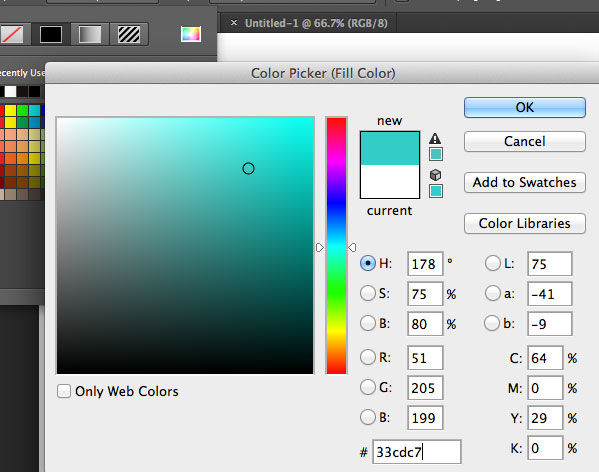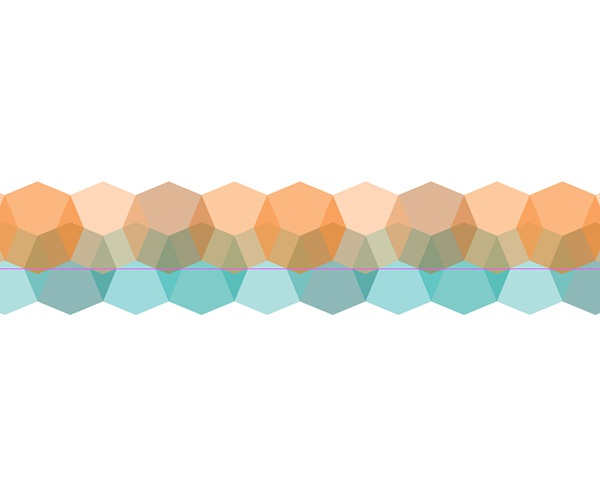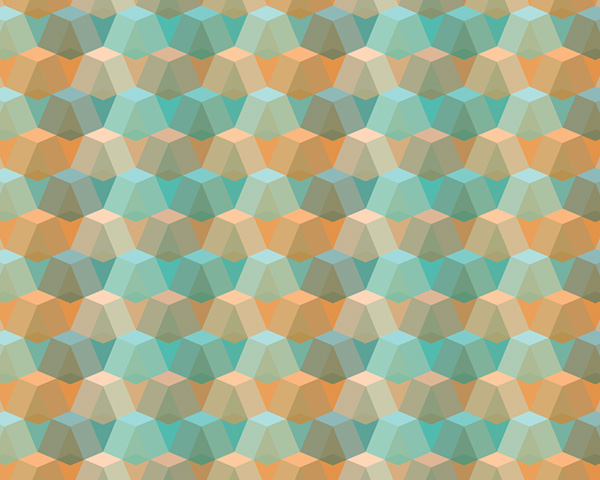
Patterns are a great way to add additional texture and depth to your designs. Some can appear to be fairly complex, and the thought of making one can be overwhelming. You may find, however, that many aren’t as difficult to create as they look. In this tutorial, I will show you an easy way to create colorful, and complex-looking geometric patterns in Photoshop.
1. The Setup
Step 1
Create a new document (File > New). It can be any size you like. I used 1280 x 1024px because I want to work with large shapes to create the initial pattern.

Step 2
Go to View > Snap and ensure that Snap is checked.

Then go to View > Rulers and have Rulers checked.

Step 3
Set up a layer with the swatch colors seen in the image below. This will make your color choosing quicker when it comes to selecting colors for this tutorial.

2. Create and Place Your Shapes
Now that you have the canvas ready and your color swatches prepared, we can start with creating our initial pattern.
Step 1
Select the Polygon Tool (U) and click on the right side of the canvas.

Make the polygon 200 x 200px with 8 Sides and click OK.

Step 2
In your Layers panel with Polygon 1 selected, make the Opacity 50%.

Change Polygon 1‘s Fill to #33cdc7.

Step 3
With Alt-Shift held, drag Polygon 1 on the canvas to your left until the shape overlaps the original shape as seen below.

Repeat this step with Polygon 1 copy and then with Polygon 1 copy 2.
Step 4
Change the Fill of Polygon 1 copy to #1d7471, Polygon 1 copy 2 to #5ccdc9, and Polygon 1 copy 3 to #009b95.

Step 5
Select Polygon 1 in your Layers panel and while holding Shift, select Polygon 1 copy 3.

With the 4 shapes selected, hold Alt-Shift and drag the group on the canvas to the left and align the shapes in the same fashion as the others.
With the 4 shapes still selected, hold Alt-Shift and drag the group on the canvas to the left and align the shapes once more.

Step 6
Now with 12 shapes in total made, create a new Group folder, name it Blue Group, and drag the 12 shapes into this group.

With Blue Group selected, move the group so that it reaches from one end of the canvas to the other.

Step 7
Next with the group still selected, hold Alt and drag the group on the canvas up and slightly to the left so that the bottom of the polygons are nested above the original group.

In the Layers panel, rename the Blue Group copy you have now to Orange Group.

Step 8
Inside the Orange Group you will now recolor all of the polygons to the orange swatches that were setup earlier. From the bottom of the Orange Group up, the pattern of colors need to be #ffb173, #ff7100, #ff9540, and #bf6f30.

Step 9
Shift drag the Orange Group down so that it overlaps the Blue Group a little more than half way.

Step 10
Select both the Blue and Orange groups and bring them down so that roughly three quarters of the Blue Group is off the canvas.

Step 11
With both groups still selected and Alt-Shift held, drag them up on the canvas so that the shapes overlap in a repeating pattern as reflected in the image below. Repeat this step until you’ve filled the canvas.

Step 12
Fill the Background layer with #d5f7fc, then Create a new layer above all of the groups and fill that with #152907 and set that layer to Subtract.

We’re almost there.

3. Define the Pattern
All right, you have your color fills, shapes overlapping, and a pretty good idea how this pattern is going to look. Now we’re going to define this pattern so it can be applied to anything you make in the future.
Step 1
Select the Rectangular Marque Tool (M).

Select the pattern as shown below.

Step 2
With the area of the pattern selected, go to Edit > Define Pattern.

Name your pattern as shown below.

Step 3
Create a new document (File > New) with whatever dimensions you like. I went with 2000 x 2000px.

Then Create a New Layer and fill it with any color.

Step 4
With Layer 1 selected in your Layer panel, choose Pattern Overlay in Layer Styles.

Select the newly defined Geometric Pattern and click OK. You should now see the pattern applied to your new layer.
If everything was selected correctly, your pattern should appear seamless. If not, go back to the original document and try to make a couple adjustments to the selection and define a new pattern.

Conclusion
In this tutorial, I showed you how to create a seamless geometric pattern in Photoshop that you can use on any new object you create in Photoshop. I hope this was a good learning experience, and you can use what you learned to continue to experiment with layer orders, color patterns, and blending modes. Depending on what you choose, you may discover new shapes in your basic geometric patterns. Have fun!

{excerpt}
Read More